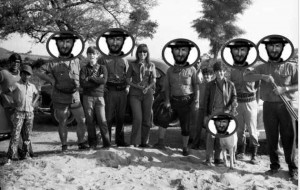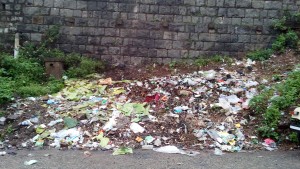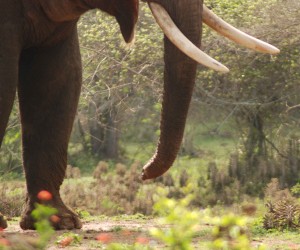ALERT
For those interested in conservation science, Corey Bradshaw maintains a very active blog. He is a professor and teaches ecological modelling.
Frankham et al. 2014. Biological Conservation, 170, 56–63.This analysis indicates that the genetically effective population size of 50 breeding adults is not adequate to reduce the effects of inbreeding depression, and the numbers required are more than 100 individuals to prevent inbreeding depression over five generations in the wild. The minimum numbers for retaining evolutionary potential for fitness should be more than 1000 breeding adults rather than the 500 that has been postulated. The authors state that this genetic information requires that population viability analysis should be suitably revised to be more effective in conservation of endangered species. This paper is of vital importance for the conservation of our large mammals such as the Asian elephant (Elephas maximus) and the Bengal Tiger (Panthera tigris tigris) that are severely affected by habitat loss and poaching in the subcontinent.
Li et al. 2014. Conservation Biology 28, 87-94.The snow leopard (Panthera uncia), and endangered species, is found in mountainous areas in 12 Central Asian countries. It is threatened by poaching, lack of prey and habitat degradation. A study in the Sanjiangyuan region of the Tibetan plateau investigated the role of Tibetan Buddhist monasteries in snow leopard conservation. Results show that 46% of monasteries were located in snow leopard habitat and 90% were within 5 km of snow leopard habitat. Therefore the 336 monasteries in this region could potentially protect 8342 km2 of snow leopard habitat through social norms and active patrols. Local herders who through their religious beliefs against killing animals could play an important role in snow leopard conservation. If this can be extended to monasteries in other Tibetan Buddhist regions, about 80% of the global range of snow leopards could be better protected.
Stankowich et al. 2014. Evolution doi 10.1111/evo.12356 (2014).Small predatory mammals in the order Carnivora are often subject to high rates of predation. A global scale analysis indicates that their adaption against predation comes under two categories: small carnivores that tend to be solitary, with warning coloration (i. e. skunks) and armed with foul smelling anal sprays, or social such as the mongooses and highly vigilant. Species with noxious sprays such as skunks tend to be nocturnal and are often preyed upon by mammals, whereas the social species such as mongooses tend to be diurnal, highly vigilant and are preyed upon by birds of prey.
If you want to be told about worldwide issues on conservation, we recommend you the ALERT website. It was put together by the famous conservation biologist Bill Laurance joined by a team of eminent and active scientists. The website is:
Davidar, one of the founders of the Sigur Nature Trust died recently. Mark’s closeness with animals was not his only contribution to wildlife conservation. Most importantly he cared about the Sigur Nature Trust, a place of unique importance because it allows the passage of wildlife on private land in between two villages, near the Mudumalai Tiger Reserve. The Sigur Nature Trust was founded by E.R.C. Davidar and his children, Priya, Mark and Peter. For more than 20 years Mark made sure that animals could cross and not be hampered by much human presence.
After he worked with Rom Whittaker at the Snake Park in Chennai, Mark established a small guest house in the family premises. One of Mark’s friends said he was like a dictator: he would not allow telephone, torches, noise. People had to obey strict rules to enjoy the marvels of nature from the safety of the veranda. It was an exceptional vantage point of view for education, a sort of real-life interpretation center.
The experiment Mark developed over more than two decades is of particular significance. The Nilgiris Biosphere Reserve where the Trust is located, is of central standing to the conservation network of southern India. It harbors one of the largest population of Asian elephant in the world and a lot of tigers as well. We can only hope that this region of exceptional beauty and biological wealth will develop into a flagship of outstanding environmental management in Asia.
To mitigate the human – wildlife conflict, we need a multitude of novel and bold experiments. Take Mark’s modest guest house for example. It can be an inspiration for the entire eco-tourism industry because it was a model on how not to disturb wildlife and still enjoy it.
Mark demonstrated we can live at peace with wildlife. We, as a family, share this vision. We will pursue the mission where Mark left it, as well as we can. The Sigur Nature Trust is a living experiment destined to create a vision for the future, based on a peaceful and knowledgeable interaction with nature. All of Mark friends can rest assured that “Mark’s place” will remain as it is. The elephants will continue to be at home. And our most fervent wish is that other people get inspired by what he has achieved and helped the Trust to achieve. For this, we are immensely grateful.
Davidar, the former Managing Trustee of the Sigur Nature Trust, ran a small guest house, Jungle Trails on the property’s land. The guest house was closed, when Mark fell ill, for several reasons. Firstly, we do not have expertise with tourism and safety issues are important when the public is concerned. Secondly, as the Forest Department was treating a wounded elephant and so we were requested to have as few people as possible in the premises in order to avoid further habituation to humans. We gladly complied with this request and the property is now closed to the public.
Right now we are trying to set-up the Trust’s procedures, website, establish research projects. This is the program for the following year and we hope to put more pictures, more videos, more news, etc.

A Saturday afternoon somewhere in British India, in September 1913, just one year before the Great War (as if it could ever be great), two Englishmen were talking:
-“What are you doing tomorrow, Jack?”
-“Nothing much, I thought about shooting a tiger or two.”
-“Don’t mind if I joined? I would be excited to go for an elephant myself.”
-“No, please, you are welcome, we will take along some brandy.”
A Saturday afternoon in September 2013 in the Nilgiris Biosphere Reserve, one day before Kumar, a villager, was killed by a frightened elephant while taking tourists illegally into a Reserved Forest, this was the conversation between two IT specialists:
-“What are you doing tomorrow, man?”
-“Nothing much da, I thought of a night jeep safari and before, a trek from the eco-resort.”
-“You don’t mind if I joined? I would be excited to come close to an elephant.”
-“No, please, you are welcome, we will have some booze as well.”
In 1913 there were tens of thousands tigers and hundreds of thousand elephants in India. Today tigers are little more than 1,000 and elephants maybe ca. 20,000. The difference between sport hunting and predatory tourism is that – no wait, there is no difference. You end-up killing the last tigers by disturbing them, you put yourself in danger and worse, you get people killed. In wildlife reserves, avoid all activity that is not supervised by trained and authorized persons.
Jean-Philippe Puyravaud

On the road to Kotagiri
When you live in the middle of the Nilgiris Biosphere Reserve, you need to be very careful with plastic because herbivores eat plastic bags and die of intestinal occlusion. In spite of the righteous boards “Plastic-free Nilgiris” placed on each road entering the Nilgiris, locally produced items are conscientiously wrapped in a layer of plastic and then delivered in a polythene bag thought to be cotton. Industrial products, of course, are almost always packaged in plastic. A single household produces maybe 1 kg of plastic per week.
I thought that, if plastic is produced in this region, it must be “treated”. As it happened, not at all. Plastic is burned by villagers or buried or left. Toxins released into the air contaminate plants, soil, surface water and groundwater. This can result in pollutants being absorbed by food crops, vegetation. Dioxins and furans occur as byproducts. Dioxin, is linked to cancer in humans, and dioxins and furans both accumulate in animal tissue. Reported effects on birds and fish, include increased mortality, decreased growth, reproductive failure and birth defects.
The “Plastic-free Nilgiris” campaign is supposed to suggest that this region forbids the use of plastic, which would be unattainable. But what it actually means is that the plastic problem is not addressed. It kills humans with cancer, pollutes the Ooty carrots and Nilgiris tea, and whatever is exposed to it. Who cares?
Plastic is a resource that can be reused and preferably less used. But as long as there is no real action, waste of resources, human lives and biodiversity will continue. The roads to Ooty with boards posting good intentions take us to hell. Too bad for the Biosphere Reserve.
Jean-Philippe Puyravaud.

Rivaldo, lucky to survive with his trunk cut after being fed by humans
Sharing food is natural among people who are close to each other, in the same family or not so close to each other, just because we belong to the same human family after all. Sharing food is a sign of friendliness. Most domestic animals were probably domesticated by sharing food with them. The trouble is that in some instance, it creates a lot of problems.
Elephants like any other animals become habituated to being fed. At the beginning, all is well. They go away. Then, they start demanding food. Elephants have a large appetite and need approximately 100 kg of food per day. Habituated elephants do not roam the jungle any more. As they find food in a particular place, they do not bother any more to explore as they normally do. They destroy all vegetation in their vicinity, accelerating their own starvation.
Habituated elephants lose their fear of humans and try to break into houses in search of fruits, vegetables and cereals. Not all people are welcoming to elephants. To defend themselves or just out of fear people will start screaming, and put their lives in danger. Alternatively, they may take a weapon and harm the elephants.
We have seen such development time after time. Our friend Rivaldo (see our videos) was extremely lucky. He became habituated, and probably went to a house where the tip of his trunk was cut. He was extremely lucky to survive. Without treatment, he would have died. Roberto Carlos was less lucky. A miscreant shot the animal in the leg and the he died of septicemia after weeks of atrocious suffering.
When you feed an elephant, you want to be friendly, but you invariably provoke the premature death of the animal. So never feed elephants.
Jean-Philippe Puyravaud.
